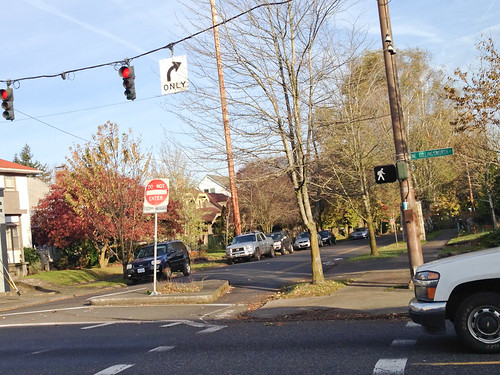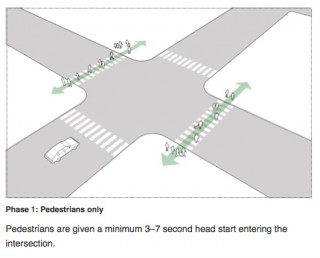
(Photo by J. Maus/BikePortland)
Have you ever noticed how the “WALK” sign over in a crosswalk sometimes turns green while your signal remains red? This phenomenon has confused a few readers who aren’t sure if they can start riding when the walk sign turns green or if they must wait for the main signal.
Here’s our first question from Dave M.:
“Hi Jonathan. They have recently switched the signal at SE Division and SE 52nd (part of the new 50s bikeway). It now is a divided signal between North and South traffic, but on both sides the “Walk” pedestrian signal goes for longer than the actual green light (going North it triggers first and then the green, and going South the green is shorter than the “walk”). Are bike allowed to cross on the “walk” signal?
Some clarification from PBOT about what they are expecting cyclists to do would be great. I’m just not sure if I should go only on the green or on either “Walk” or green.”
And Fritz F. had a similar question:
“I have noticed that the light at N Williams & NE Killingsworth triggers the cross walk signs several seconds before the traffic light turns green for traffic on Williams. Several times, especially during the summer, I have seen riders go through the intersection in the bike lane while the cross walks are triggered, but not the traffic light. Normally I wait for the light to turn green before proceeding, but I’ve recently had people yell at me for not going. Legally who is in the right and why doesn’t the city place a cycle green light to avoid confusion at this light?”
To get some clarification, we got in touch with Peter Koonce, PBOT’s manager of signals, lighting and Intelligent Transportation Systems (ITS).
Koonce said the intersections above have been given a treatment known as a Leading Pedestrian Interval — or LPI in wonky parlance. LPIs are installed to give people who are using the crosswalk a head start by giving them time to establish their right-of-way over people making right turns. Koonce says in the case of NE Killingsworth and Williams, the city did the LPI because, “We had historically poor compliance by motor vehicle operators — right turns on red were becoming failure to yield to pedestrians.”
According to the NACTO Design Guide, “LPIs have been shown to reduce pedestrian-vehicle collisions as much as 60% at treated intersections.”
But the question remains: Are people on bikes (who are not using the crosswalk) allowed to go early as well? The answer is no. An LPI is only for people using the crosswalk. As tempting as it is, if you are biking in the standard traffic lanes, you must wait for the signal to turn green.
Even though it’s technically illegal, I’ve observed many people on bikes think they can go on the green walk signal. Koonce noticed similar behavior on a recent study trip to Cambridge, Massachusetts where they’ve implemented LPIs at every intersection (it’s a major college town and there is a high volume of foot traffic). “People on bikes would use them… They’d just jump into the intersection.”
In Cambridge, Koonce said walkers get only a three-second head start. But in Portland, he tends to provide five to 10 seconds depending on how busy the intersection is and how wide the street is. The added green time for the walking movement means there’s less time for the other signal phases. That can make LPIs a difficult choice in very congested areas where Koonce says, “every second counts.”
Koonce uses LPIs selectively and reviews each request (which come from traffic engineers) individually. While not every request is approved, Koonce said he tends to err on the side of safety. “There still isn’t a lot of research to suggest they are proven countermeasures to conflicts, but I tend to think they do improve safety. I just worry that people disregard the signal when it’s congested.”
Koonce estimates there are about 30-40 intersections in the city with LPIs. (There’s a new one at N Williams and Alberta and also one at SE 39th and Clinton.)
Next time you come across this situation, try and resist the urge to jump the signal even though the crosswalk sign has turned green. And if someone behind you gets impatient with you, just turn around and tell them, “Chill out man, it’s an LPI. I read about it on BikePortland!”
— Answer more of your burning bike questions in the Ask BikePortland archives.
UPDATE: Commenter Chris Monsere (who also happens to be a noted researcher at PSU) shared that Washington D.C. passed a law in 2013 allowing bicycle riders to cross with the LPI.


